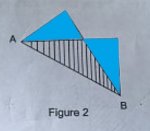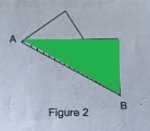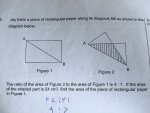You are using an out of date browser. It may not display this or other websites correctly.
You should upgrade or use an alternative browser.
You should upgrade or use an alternative browser.
Mum needs help - Finding area given ratio
- Thread starter faint2018
- Start date
mmm4444bot
Super Moderator
- Joined
- Oct 6, 2005
- Messages
- 10,902
Rubbish! I used to play cribbage, 40 years ago. I can't remember how it goes. Does this mean I'm a cribbage failure?… pardon me as I’m a math failure …
I don't know what your son has learned about ratios, proportions, symmetry, or algebra, so I'm going to guess that he already has experience with all of it. He's welcome to communicate directly with us about what he finds confusing. We'd like to see any work that he's able to try.
For ease in typing, I'm going to use upper and lower case letters, for the figures' areas.
F = the area of Figure 1
f = the area of figure 2
One way to find F, is to write and solve a proportion. (It's the first method that came to mind because the exercise gives us a proportion.)
Your son knows the three ways to write ratios (using words like "to" or "per", using a colon, using a fraction).
Your son knows that two equal ratios form a proportion.
Your son knows the following pattern for solving proportions:
Given a proportion in the form: A/B=C/D
we write: A∙D = B∙C
The exercise's second sentence gives us the proportion:
\(\displaystyle \dfrac{f}{F} = \dfrac{4}{7}\)
Before we can solve this for F (that's what we're asked to find), we first need to express f in terms of F. That is, we need to look for a relationship between areas f and F, so that we can find a way to represent the area of figure 2 using symbol F instead of f. Otherwise, our equation will contain both symbols (f and F) and that isn't enough information to solve for either one.
The key is realizing (from symmetry) that the two unshaded triangles in figure 2 (shown in blue) are the same shape and size; therefore, they each have the same area.

Next, see whether your son can identify the part of figure 2 that is exactly one-half of Figure 1 (F/2). It's shown below, in green.

The following image shows that F/2 is comprised of two areas; one is blue, and the other is the shaded area (orange) which measures 24cm2.

Therefore, if we subtract the orange area from F/2, what's left is the blue area:
\(\displaystyle \text{Blue Area} =\)\(\displaystyle \dfrac{F}{2} - 24\)
At this point, show your son that area f (figure 2) is the same as F/2 (green area) plus one blue area. This relationship between F and f allows us to express f in terms of F.
\(\displaystyle f = \)\(\displaystyle \dfrac{F}{2}\)\(\displaystyle + \)\(\displaystyle \dfrac{F}{2} - 24\)
Have your son simplify this new expression for f and substitute the result for symbol f in the exercise's given proportion.
By doing this substitution, the proportion will contain only symbol F, allowing your son to solve it in the usual way.
If he gets stuck, have him come back and show what he's done. We need to see where he's stuck, before continuing.
Cheers :cool:
Last edited:
Hi, I’m struggling with this Q, pardon me as I’m a math failure ?. Trying my best to guide my son.
can anyone help to guide me on this Q?
thank you!!
alternatives to mmm4444bot's solution;
F1 is 7/7, fig 2 is 4/7 F1.
the difference between F1 and F2 is one shaded area, 24, i.e. you are covering up the shaded area.
the difference is also (3/7) F1, so you set them equal.
that is (3/7)F1=24, and solve for F1.
or/
2(24)+2a=F1; where a is one unshaded area of F2.
and 24+2a=F2.
and 7F2=4F1.
solving these 3 equations for F1 yields (3/7)F1=24, solve for F1.
mmm4444bot
Super Moderator
- Joined
- Oct 6, 2005
- Messages
- 10,902
Thanks for posting the alternates, sinx. I like the first one. :cool:… F1 is 7/7, fig 2 is 4/7 F1.
the difference between F1 and F2 is one shaded area, 24, i.e. you are covering up the shaded area.
the difference is also (3/7) F1, so you set them equal.
that is (3/7)F1=24, and solve for F1.
About halfway through, I had considered switching to your second approach, but decided to continue with my pictures, instead (for mum).
Thanks for posting the alternates, sinx. I like the first one. :cool:
About halfway through, I had considered switching to your second approach, but decided to continue with my pictures, instead (for mum).
I have to admit I did not see the shaded area (the difference in area) was 3/7F1 until after the algebra revealed it, but it does offer another way to skin a cat.
i included the algebra approach to show that an insight is not necessary. [including the insight that folding along a diagonal leaves F1/2.]
I wanted her to see that as long as there are at least as many equations as unknowns, you can solve it.

